Issue Archive
Table of Contents
EDITORIAL
Introduction to a review series on mechanisms and clinical implications of clonal hematopoiesis
We present a Review Series of cutting-edge articles on clonal hematopoiesis. Edited by Associate Editors Margaret Goodell and Bertie Göttgens, the series discusses the mechanisms driving the development of clonal hematopoiesis, the associated risks posed by clonal hematopoiesis for patients with hematologic and nonhematologic disorders and patients with inherited bone marrow syndromes, and the clinical ramifications of discovering clonal hematopoiesis and sharing the results with patients.
BLOOD COMMENTARIES
PLENARY PAPER
Hemolysis in the spleen drives erythrocyte turnover
In a Plenary Paper, Klei and colleagues present a paradigm-shifting mechanism for the removal of senescent erythrocytes by the spleen. Having found that freshly isolated splenic tissue demonstrates very low levels of phagocytosed red cells within macrophages, they demonstrated that senescent red cells adhere to the splenic extracellular matrix and hemolyze to red cell ghosts that then undergo phagocytosis by red pulp macrophages.
REVIEW SERIES
Mechanisms and Clinical Implications of Clonal Hematopoiesis
CLINICAL TRIALS AND OBSERVATIONS
Optimized tandem CD19/CD20 CAR-engineered T cells in refractory/relapsed B-cell lymphoma
Clinical Trials & Observations
Chimeric antigen receptor (CAR) T cells are effective therapies for relapsed/refractory B-cell malignancies. However, relapses occur, often in the setting of tumor cell loss of target antigen expression. The authors demonstrated that CAR T cells engineered to target 2 tumor antigens have robust antitumor activity and excellent clinical efficacy and do not appear to be associated with loss of tumor antigen expression.
NextGen CARs: the race is on
Clinical Trials & Observations
IMMUNOBIOLOGY AND IMMUNOTHERAPY
Immunoglobulin light-chain toxicity in a mouse model of monoclonal immunoglobulin light-chain deposition disease
Light-chain deposition disease (LCDD) is a rare monoclonal gammopathy of renal significance that occurs without evidence of frank multiple myeloma or other malignant plasma cell dyscrasia. The authors created a faithful mouse model of LCDD and demonstrated that treatment with proteasome inhibitors blocks progression of and partially reverses renal failure, supporting the use of chemotherapy to preserve renal function despite absence of malignancy.
LYMPHOID NEOPLASIA
IL10RA modulates crizotinib sensitivity in NPM1-ALK+ anaplastic large cell lymphoma
Clinical Trials & Observations
Anaplastic large cell lymphoma driven by the NPM1-ALK fusion is a rare T-cell lymphoma seen primarily in pediatric patients. Most patients respond to ALK inhibitors with crizotinib, but some patients develop early progression suggestive of primary resistance. The authors characterized the signaling pathway responsible for crizotinib resistance, demonstrating that aberrant upregulation of IL10RA mediates direct activation of STAT3 in a pathway that bypasses the need for NPM1-ALK1.
MYELOID NEOPLASIA
HHEX promotes myeloid transformation in cooperation with mutant ASXL1
ASXL1 is commonly mutated in myeloid neoplasms, but previous studies suggest that it is not sufficient for myeloid transformation. Takeda and colleagues demonstrated that HHEX, a homeobox gene that is highly expressed in stem cells and leukemia cells, cooperates with ASXL1 in promoting myeloid transformation through regulation of MYB and ETV5.
THROMBOSIS AND HEMOSTASIS
Factor XII and kininogen asymmetric assembly with gC1qR/C1QBP/P32 is governed by allostery
The contact system, composed of factor XII, prekallikrein, and high-molecular-weight kininogen, plays a role in both coagulation and innate immunity. Kaira et al resolved the crystal structure of the contact system binding to the globular C1q receptor (gC1qR). They propose that gC1qR acts to cluster the factors of the contact system as a prelude to the initiation of coagulation.
BLOOD WORK
-
Cover Image
Cover Image
![issue cover]()
ALK+ anaplastic lymphoma cells exhibiting enlarged irregular nuclei with homogeneous cytoplasmic staining for interleukin 10 receptor subunit alpha (IL10RA, brown) by immunohistochemistry staining. IL10RA modifies sensitivity to ALK inhibition by activating STAT3 bypassing NPM1-ALK. See the article by Prokoph et al on page 1657.
- PDF Icon Front MatterFront Matter
- PDF Icon Table of ContentsTable of Contents
- PDF Icon Back MatterBack Matter
- PDF Icon Editorial BoardEditorial Board
Advertisement intended for health care professionals
Email alerts
Advertisement intended for health care professionals


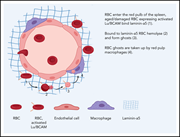
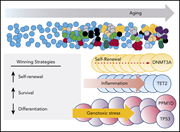
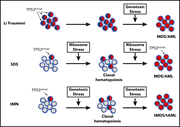
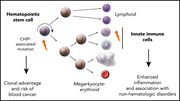
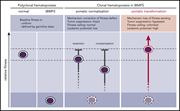
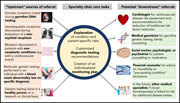
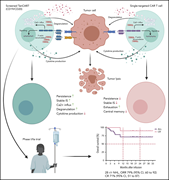
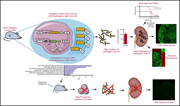
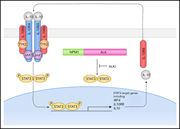
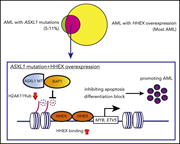
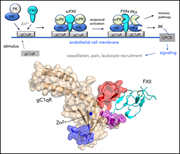

Turning over a new leaf on turning over RBCs